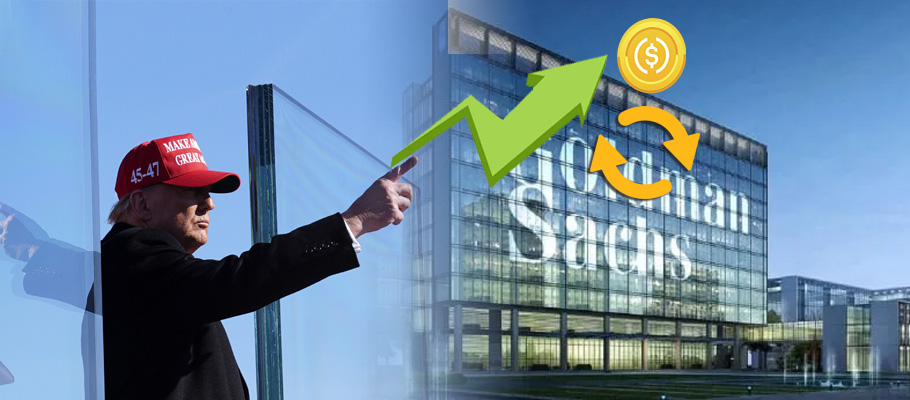
Published: May 7th, 2025
Despite USD's steady rise into early May, analysts at Goldman Sachs believe a backdrop of growing economic risks changes the outlook to negative.
Near-term gains are still possible after significant selloffs, and further strength could be in the cards, however the likelihood of new USD lows in the coming weeks has become elevated thanks to the Trump administration's fundamental repositioning of America's place in the global financial order.
In a research note published this week, Goldman downgraded its outlook for the Dollar, saying the post-WWII consensus has been good to America, and that President Donald Trump's plan to re-tool it will challenge US exceptionalism, with a potential loss of privileges.
Trade and economic agreements signed after 1945 have allowed Washington ‘to sell large volumes of Treasury bonds to foreign investors, and enabled USD to become the world's dominant currency,’ the research note explains.
Still, upending the current system has ‘the potential to diminish these advantages.’ Since taking office, Trump has announced numerous tariff hikes. While follow-up announcements suggest the tariffs will be scaled down, by year's end the overall tariff level leveled against foreign imports will be at their highest levels since 1945.
Goldman's analysts wrote that if tariffs become a drag on the profit margins of American companies and erode consumers' real incomes, ‘American exceptionalism may be eroded as well, weakening the strong Greenback as a central pillar.’
Goldman’s base case now assumes that tariffs will have a negative impact on US profits and degrade real incomes.
In early April the Pound to Dollar rate experienced a steep sell-off but analysts expected it to climb back if continued negative takes on the robustness of the US economy and a deterioration of other important metrics weighed on the Greenback.
GBP/USD dropped close to 1.99 per cent on April 4th as the escalating trade stare-down between Washington and Beijing intensified a meltdown in global equity markets. The US Dollar benefitted amid the turmoil from its safe haven status, coming back notably from the previous day's losses.
The gains were short lived however given widespread pessimism over how the American government's sweeping new tariff regime will impact US economic growth. In an investor note, Goldman Sachs analysts captured market concerns about what the levies may herald for US bonds, equities, and USD.
‘We are re-calibrating our outlook for the Dollar in the coming quarters. We now expect the USD weakness seen in Q1 to persist and deepen.’
Goldman raised its forecasts for numerous currencies relative to the Greenback last week, including the Pound, which is now expected to rise to 1.32, 1.35 and 1.38 over three, six and 12 month timeframes. Each represents an uplift from earlier Goldman projection.
The bank's analysts believe Trump's tariff strategy will diminish the spending confidence of companies and households, causing economic growth to shrink while undermining a transatlantic growth differential that has kept the Greenback ‘overvalued’ overvalued and ‘inflated US equity markets for 10 years or more.’
In November 2024, Goldman analysts were calling the Pound a potential ‘hidden gem’ in their most recent year-ahead forecast. Published on November 19th, the bank's report listed a set of post-election targets pointing to solid gains for Sterling in the coming months.
Pointing to GBP's ‘bullish set-up,’ Goldman said the Pound ‘should keep pace with a broader appreciation in the Dollar.’ Given Goldman Sachs' central position in the global financial architecture, the bank's outlook influenced how traders set their expectations of the forex market in the coming months.
One prediction in the year-ahead forecast was for the Pound to Euro exchange rate to rise well above 1.20. ‘We have maintained a constructive view of GBP over much of 2024, and we believe the rationale is still there for ongoing outperformance by Sterling on G10 crosses over the next few months.’
Goldman's report landed in the aftermath of Donald Trump's US presidential election victory, which also saw his Republican Party win majorities in both houses of Congress.
Trump 2.0 looked ready to shake up global trade while strengthening America's economy, a scenario which would have kept US interest rates ‘higher for longer’ than other major currencies.
New US import tariffs were expected to hit the Eurozone's all-important exports hard, while higher Fed rates might ultimately mean gains for the Greenback.
‘We see that as a powerful supportive mix for the Dollar,’ Goldman's report adds. ‘As a result, we are no longer looking for broad depreciation by USD, even on a six or twelve-month timescale. We see USD staying stronger for longer.’
In August 2024, Sterling faced down an extended selloff against a backdrop of sinking global stock markets and worries that the US economy was faltering.
The Pound to Euro rate dropped 0.60 per cent on 21st August after the Bank of England (BoE) cut interest rates by 25 basis points. US equities markets fell the day after as earnings from big technology companies came in well below expectation.
A research note from Capital Economics said those factors created additional selling pressures in the Asian session, when Japan's Nikkei 225 index fell by more than over five per cent. ‘In our view, such a steep and sudden decline points to a wider bout of global risk aversion.’
Risk-averse sentiment can negatively impact Sterling, which was already feeling the pressure after the Bank of England made its rate cut. The Pound to Euro conversion fell below 1.18 on Tuesday 6th August to touch 1.1773, a level last seen in early July.
Historically, GBP tends to lose value against USD, EUR, CHF and Yen when market sentiment turns gloomy. It can also gain against ‘high beta’ currencies like the Norwegian Krone and the Australian and New Zealand dollars.